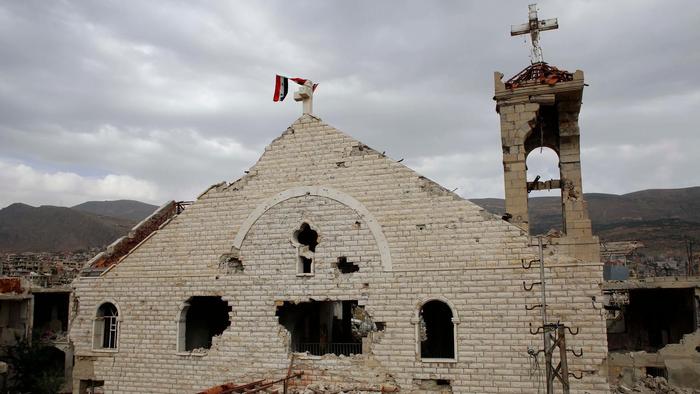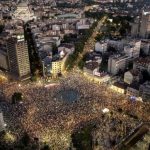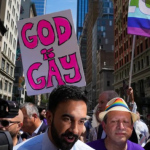Authored by Brad Hoff via The Libertarian Institute,
Years ago I wrote about my first encounter with Syria as a young twenty-something year old fresh out of active duty service in the Marines: “My first visit to the region while desiring to study Arabic in 2004, just after completion of active duty service, and while still on the inactive reserve list, began a process of undoing every assumption I’d ever imbibed concerning Middle East culture, politics, and conflict.” I introduced in that fairly widely-read essay with the provocative title, A Marine in Syria, “An initial visit to Syria from Lebanon was the start of something that my Marine buddies could hardly conceive of: Damascus became my second home through frequent travel and lengthy stays from 2004 to 2010, and was my place of true education on the real life and people of the region.”
I recounted that this first visit to Damascus was a mere one year after the US invasion of Iraq. “While fellow service members were just across Syria’s border settling in to the impossible task of occupying a country they had no understanding of, I was able view a semblance of Iraq as it once was through the prism of highly stable Ba’athist Syria.” A key personal detail I had left out of that account is that I met my now wife on that initial fateful trip. After I spent those early summers staying in Damascus, mostly seeing and traveling around the country with her, we married in 2006 at the historic St. John of Damascus Orthodox church just off ‘Straight Street’ in the walled Old City of Damascus. We began our life there during those better times.
Ironically enough our first ever fierce argument happened on just our second or third date, during that 2004 trip. Discussing the raging Iraq War then unfolding across Syria’s eastern border while strolling in a public park, Reem said, “You know… the Americans are coming here next.” My immediate haughty laughter and scoffing dismissal of such a far-fetched scenario as the U.S. ever attacking Syria had angered and annoyed her. “Impossible,” I quipped, and implied that she and other Syrians that were then warning me of a near-future war on Syria could be chalked up to “Arab paranoia” which tends to assume a U.S. hidden hand and machinations behind every bad geopolitical event. In the early evening, surrounded by random other Syrians, we had a shouting match – with me actually defending America and George W. Bush’s “good intentions” – and with her warning me that Syria is top of the U.S. war machine’s target list. “A war on Syria is coming. The Americans are coming here – whether in a few years or more, they will target Damascus,” she said. “Israel will be part of it too.”
Fast-forward to today, and a horrific decade-long war in Syria later… we live in Texas, and she still on occasion reminds me of “our first fight”. She was exactly right of course, tragically. She hadn’t been the only one: many of her Syrian Christian friends had – more than a half decade before the war unfolded in 2011 – tried to warn me that Washington is actively eyeing Syria for regime change “next” after Iraq.
I believe it was when I was temporarily living in Damascus in 2005 that I began to believe her and her friends were on to something. One Friday night out we were in a big group of young professionals, and at dinner at a restaurant everyone was abuzz over the news of a very unusual government-authorized memo. It had circulated that week to all private businesses and entities in Damascus and major cities. All Syria-based companies were being warned by the Baath government of Bashar al-Assad that they must temporarily halt any new business dealings or implementing fresh contracts with US-based international companies, specifically dealings that would involve junkets where Westerners would be invited to spend any significant amount of time inside Syria.
The allegation was that US and Western spies or assets were using business contacts to infiltrate Syrian companies and even government entities. At that dinner, my Syrian friends began to joke that “Brad might be CIA” – leading to lots of laughter, and admittedly a bit of discomfort (given that one of our friends actually harbored these suspicions all the way up till I married Reem and we started having children… this was apparently finally proof enough that it wasn’t all a “front”).
Dinner table banter and speculation over “a coming war for the Middle East” aside, that was the year CNN’s Christiane Amanpour told Assad to his face that regime change is coming for him. This was in a 2005 televised and archived interview, now for all posterity to behold…
CNN in 2005 – US wants regime change in Syria
Washington was “actively looking for a new Syrian leader” looong before the civil war in Syria began
— Maria ⏳ (@ml_1maria) November 1, 2019
Amanpour, it must be remembered, was married to former US Assistant Secretary of State James Rubin (until 2018), who further advised both President Obama and former Secretary of State Hillary Clinton. And of course it was during the Obama years that the massive CIA covert program to fund and train so-called “moderate rebels” – detailed and revealed in The New York Times as Timber Sycamore – kicked off (though given Assad is obviously still in power, the regime change efforts failed, with a brutal ‘sanctions warfare’ regimen taking its place).
The point of these personal anecdotes and memories, which I’m sure are not unique to any Westerner that spent time in Syria during those perhaps “deceptively stable” pre-war years of the mid to late 2000s, is to say that these recollections are what in large part spurred my recent efforts to interview Syrians, and especially Syrian Christians, who had experienced or fled the war.
I learned through these interviews, many of which are detailed in my new book Syria Crucified with co-author and friend Zachary Wingerd, that Syrian Christians in particular were so on edge during those opening years of the US occupation of Iraq precisely because Iraqi Christian refugees fleeing from across the border toward Damascus were actively warning Syrian Christians, “You are next!”
A number of Syrians had told us that years before the war started in 2011, they understood that not only was Syria top of the list for regime change, but that Christians in particular would be targeted in a planned sectarian war – just as in Iraq. Though it remains a story for another time, as it is still till this day too sensitive to discuss openly, I have gained confirmation from a handful of Syrian Christian individuals that in 2010 into early 2011 (just before the conflict started in Syria), U.S. intelligence officers were contacting them and very aggressively seeking their assistance – trying to make them assets. While these particular individuals are not featured or mentioned in my new book (again, given the sensitivity of the information and individual situations), I’ll just note that in every instance that I’ve been able to confirm, the U.S. case officers were told by the Syrians “screw off!” – or some variation thereof.
Suffice it to say that some Syrian Christians had been essentially tipped off by U.S. intelligence operatives that something big was coming for Syria, again, significantly prior to the actual start of the war. In one glaring instance, an official from the then existent U.S. Embassy in Damascus (it closed in February 2012) tried to convince a well-liked local Syrian Christian man who had spent a career working for major American news outlets in the Middle East (thus he had a lot of high-level media contacts across the globe) to become part of the U.S.-recognized “political opposition” in Syria. Keep in mind this was before such an “opposition” body was even brought into existence.
The focus on my own research into the plight of Christians during the war began in earnest all the way back in 2014, when I wrote the following for my now-defunct blog:
One potential map of the Middle East, created by retired Col. Ralph Peters, envisions a future division according to Shia, Sunni, Kurdish regions, with absolutely no place for Christians, who will be “cleansed” through genocide or forced immigration. One article Peters wrote was called “Blood Borders” because he admitted that minorities would have to be killed off for his map to make sense! (Yes, as in well-known FOX News contributor Ralph Peters).
Many have seen “Greater Lebanon” (which is extended far north beyond it’s actual boundaries up through Latakia in the “imagined map” below), as what would become a primarily Christian enclave after neighboring states would be emptied of the indigenous Christian presence…

Or worse, during opening years of the war in Syria maps like the below emerged, with analysts suggesting Christians would have to flee to an Alawite “rump state”…
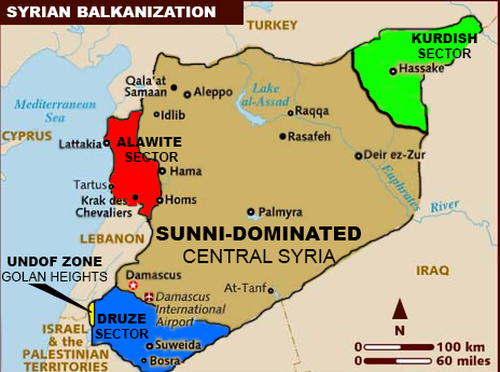
I wrote further in that prior 2014 article about how some European Union countries were shipping weapons to jihadist insurgents while simultaneously offering Syrian Christians asylum if they left their war-torn homeland:
While some might understandably benefit by France’s latest offer [of political asylum for Middle East Christians], and this might be good for those individuals and families who have already suffered enough, the Orthodox Church Patriarchate has a firm understanding of the current and future designs of Western policy makers. Ethno-religious sectarianism was not a shaping reality for 20th century Arab nationalist movements, but is the long-term strategic plan of Saudi Arabia. Through the help of its closest ally, the United States, along with other western countries, the logic of sectarianism is being implemented, and there are few who understand the nature of the game.
Syrian Church leaders had called it the West’s “Trojan Horse” plot vis-a-vis Mideast Christians: encourage Christian emigration from the region while at the same time covertly shipping in the very weapons that would be used to target Christians who tried to remain (given also that local Christians by and large stuck with the Assad government, which would prove a very “inconvenient” problem for U.S. policy given efforts to overthrow said government). This theory received some degree of validation when I wrote the below 2015 article based on a leaked classified Saudi cable – an article later circulated by WikiLeaks…
Did Saudi Arabia Barter in Christian Lives with the #Vatican? http://t.co/zDpkaOK1QR
See: https://t.co/RsleSyCc5Q
— WikiLeaks (@wikileaks) July 14, 2015
Saudi to Vatican: Help us bring down Assad and we will ensure Christians are spared from retaliation #SaudiCables https://t.co/zSr60GOm91
— WikiLeaks (@wikileaks) July 7, 2015
Our new book, Syria Crucified: Stories of Modern Martyrdom in an Ancient Christian Land provides ample testimony and examples confirming Syrian Christian suspicions that Washington had long been OK with “throwing Christians to the lions” while seeking to topple Assad (as a 2013 NY Times article put it).
For example, we quote the Antiochian Orthodox Church’s Bishop of Baghdad and Kuwait, Ghattas Hazim, who described during the height of the Iraq War that “Christians are being slaughtered in Iraq and the West does not lift a finger to protect them.”
At the height of the war, high-ranking Syrian Church leaders went to the White House to plead with then President Obama to abandon disastrous regime change policies…
Christian leaders meet Obama, discuss concerns for Mideast minorities http://t.co/3jzEtp6M8Q pic.twitter.com/x8cmJa2Fg2
— Catholic News Service (@CatholicNewsSvc) September 13, 2014
This suspicion that the West was pursuing an unspoken agenda of initiating and exacerbating a sectarian conflict that would break apart Syria, ultimately leading to the liquidation of Syria’s ancient some two-million strong Christian community (like happened to a large degree in Iraq), was echoed by a Syrian Christian physician named Shaza, who Zac and I spoke to extensively.
She had for decades been a practicing physician out of offices in Damascus, until she fled to the United States after her family was nearly killed by sniper fire and mortars as Al-Qaeda encroached on her neighborhood (the story is recounted in chapter 2), setting up checkpoints just minutes from her home and kids’ school. There are many similar stories that fill this new book, and I’ll end this meandering essay by providing one heart-wrenching example from the book below.
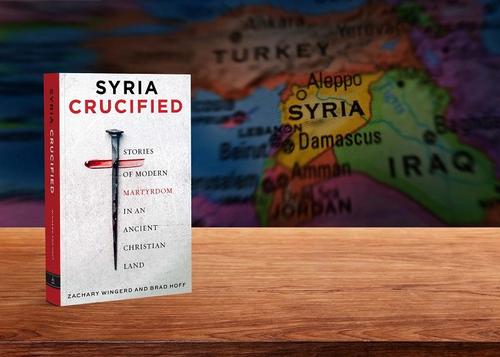
Below is the Syrian doctor Shaza’s story, excerpted from the book…
* * *
As Shaza mused on the catastrophic shift from an idyllic life to one of upheaval, she recounted being given a forewarning of the Syrian Christian tragedy. As a physician Shaza ministered to those displaced due to the Iraq War: “I worked with the Iraqi refugees from 2003 to 2010 in a charity center. It’s a program done by the Church, but they are accepting all the people – Christians and Muslims.” Little did Shaza foresee that less than a decade into the future it would be Syrian Christians themselves caught in dire straits.
Shaza related how a number of Iraq refugees tried to warn her:
They talk about horrible stories. They’re kidnapping, killing, raping. When they trust me after a couple of years, they keep saying, “Have a plan B. They are going to do this with Syrian Christians.” I keep saying, “No, it will not happen.” They keep saying, “No, it’s going to happen, so think about what is your next step if it’s happened.” And we didn’t think about that. We never thought that this will happen in Syria. Most of the Syrians – they keep saying that it’s protected because it’s a strong region. I have been to Iraq and to Jordan, to Egypt, in the past as a tourist – I saw poor people. We never see them in Syria. We have no homeless people in Syria. It’s a prosperous country. It was a good country, but after, I think, 2006 or ’07 till 2010, we began to notice something. Maybe politics, maybe economic, I don’t know what’s the problem, but something happened, you know. Makes the people more poor so more suffer. They have these thoughts of revolution. I think that made them easily accepted this.
Figures gathered by the United Nations High Commissioner for Refugees (UNHCR) showed that by 2007 the number of Iraqi refugees that fled into Syria exceeded 1.2 million. Most of these were unregistered, meaning they had trouble being reached with international humanitarian aid or accessing Syrian government services. A report cited by the UN Office for the Coordination of Humanitarian Affairs (OCHA) during that period underscored that displaced Iraqis were helped “mostly through local Church organizations.” The financial burden on Syria, whose population was less than twenty million, of abruptly absorbing over one million impoverished Iraqis in need of housing, health care, and education helps explain some of the economic decline just before the war that Shaza mentioned.
She then pondered the origins of the early uprising in Syria and how rapidly it became militarized and internationalized:
I keep thinking of the Free Syrian Army. I heard about some young people who have their thoughts of freedom. They believe in these thoughts, but they were like the chess pieces. Somebody is moving them for his own ideas… When they faced with the extreme Muslims, they lost their lives. Those extreme Muslims open the roads to the strangers to come. I can’t even imagine that Syrian people want to destroy our history, our old cities, our old things, because it means a lot for them as a Syrian. But for the strangers, it means nothing. It’s easy to destroy everything.
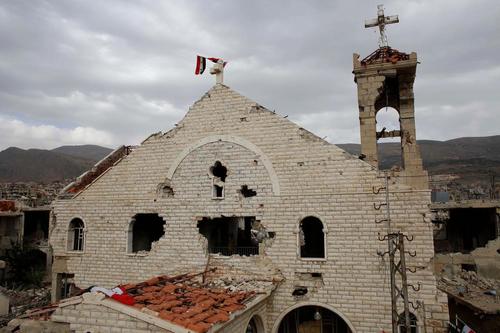
* * *
To read more, order the book Syria Crucified direct from the publisher, or through Amazon.

